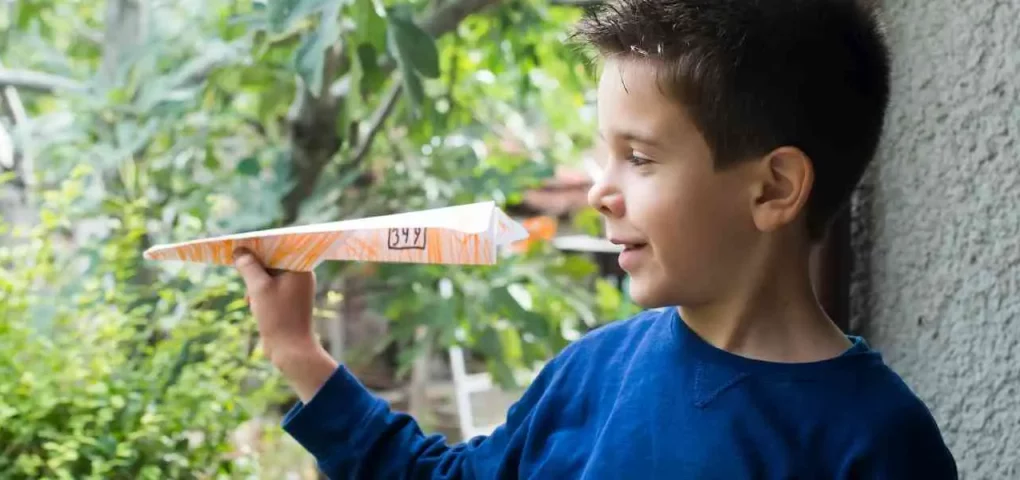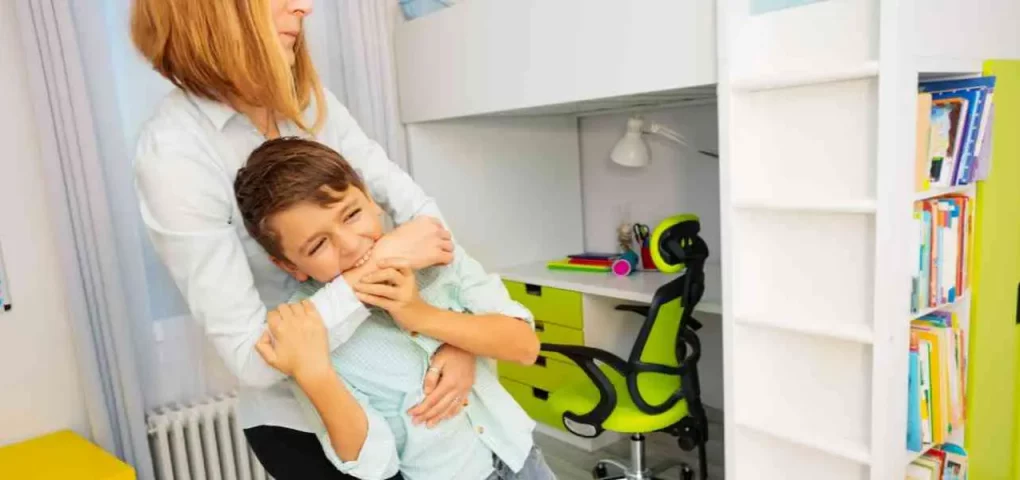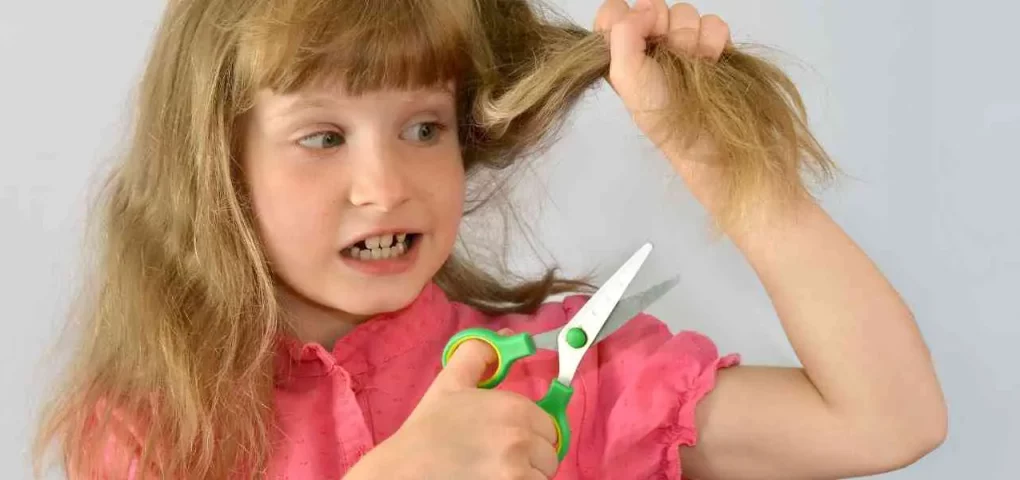
Is your child’s behavior a bit naughtier than usual these days?
Before you lash out at your child’s behavior or tear your hair out in frustration, it’s important to understand the reason behind your kid acting like a really naughty child. You might be surprised to find out that it has actually nothing to do with your kid intentionally trying to frustrate you.
This article will look at five common child behavior scenarios that parents often mistake for “bad” behavior and explain the science behind each.
Ready? Let’s dive in!
Scenario 1: Throwing objects to the ground

Have you ever gone through this stage where you give your child a toy and tell them, ‘Don’t throw that!’, but they throw it anyway? Yeah? Thought so too. And especially when they’re in their “terrible twos.”
If it feels like your child is doing everything you’re telling them not to – whether it’s touching, eating, or messing with something you said they shouldn’t, it’s not because they’re being stubborn. At least, not intentionally.
Child development experts have found out that children do not start developing the ability to control themselves until 3 or 4. And there’s really nothing you can do to speed it up as their brains are not yet fully developed. In fact, it’s a long process that reaches well into the adolescent phase.
So the next time your child acts impulsively, just remember that they have yet to develop the skill of self-control. For now, consider it a great way to exercise your skill of keeping your emotions in check 24/7.
Scenario 2: Throwing tantrums everywhere. Literally.

Did we just describe a nightmare? Because for most parents, if not all, this one is a nightmare come true.
Just imagine, you’re at Target, and your toddler suddenly goes into a screaming fit as they point at a toy they want you to buy. And geez, it’s not just at Target. They do the same thing at the park, and at the daycare. Wherever and whenever they get the chance to throw a massive fit.
And you know what’s even worse? The more you try to shush them, the louder they cry and scream.
Now you get people shooting disapproving glares at you like you’re the worst mom ever. Ugh. Talk about a very stressful situation.
But why exactly do kids throw a tantrum anyway?
The answer can be summarized into just one word: overstimulation.
When kids are overstimulated, a.k.a. stressed out with so many things happening in their lives, the more likely they are to throw tantrums. Think of it as their way of expressing the cumulative stress and exhaustion they’re feeling.
So if your child seems to be throwing too many tantrums these days, you might want to check your current schedule. Does your child still get sufficient rest in between all the fun and play and other activities you’ve scheduled for them?
Grown-ups aren’t the only ones who need a break, y’know. Kids too! And yep, that includes taking a break from playtime and other activities. So try increasing their ‘down’ time; you might be surprised to see you child’s behavior improve in the coming days.
Scenario 3: Non-stop crying sessions

Don’t worry, momma, every new parent has had to go through these days. So if you feel like your toddler’s non-stop crying sessions are stretching you too thin. . . time to take a deep breath!
You’ve probably noticed by now that kids are more ill-tempered when they’re feeling any of the following:
- Hungry
- Thirsty
- Sick
- Tired
It’s not them being a “crybaby” (pun intended), and it’s just how nature is.
As much as we’d rather have our kids tell us what’s wrong rather than just burst into tears at the most unexpected times of the day, they just can’t. They’re too young to communicate what they feel. And so, the only way for them to vent out their emotions is just to cry.
Hangry? Cry. Can’t sleep? Cry. Having a headache? Cry. Caught a cold? Cry.
Thankfully, this phase doesn’t last forever. But there’s no other way to get ’round this stage than just go through it, one crying session at a time.
And oh, one more thing. Kids can’t handle big emotions as the grownups do. In fact, if we’re being 100% honest with ourselves, we don’t control big emotions as well as we should, too, sometimes.
Kids can’t ‘hold it all in’ or distract themselves from unwelcome emotions. So the only choice they have is to vent it all out. Often with tears.
Rather than punish them for expressing their emotions this way, child development experts suggest that parents just let their children be until they learn how to handle their emotions better.
Scenario 4: 1000% energy levels on 'normal' days

“Stop running after your brother!” “Don’t mess around the table!” “Stop jumping off the bed!” Feels like we’re reading off your daily litany at home? That’s because we’re mind-readers. (wink)
Just when you thought you were going to have a moment’s rest from making sure that your toddler doesn’t flip the whole house upside down, your kid comes up with another genius idea. Like, putting that Sharpie to good use on your *gasp* pristine, white walls.
And here you thought their non-stop crying sessions were already the worst part you’d had to go through. Well, welcome to mom life!
Kids thrive on laughter, excitement, and surprises, so be prepared to play a goofy trick or two every day. Every day for them is ‘play day.’ They have no idea about your current work schedule and that you have 1,000 things on your to-do list, so they’ll ultimately end up messing around in their efforts to get you to play with them too.
Plus, they’re still in that stage where they have a developmental need for lots and lots of movement. So if they always seem to be all over the place, crawling under the bed, jumping off of things, racing around, tumbling, all that is just part of their childhood.
When you think your child’s behavior might be a problem, you have 3 choices: Decide that the behavior is not a problem because it’s appropriate to the child’s age and stage of development. Attempt to stop the behavior, either by ignoring it or by punishing it. Introduce a new behavior that you prefer and reinforce it by rewarding your child.
That’s just how things are, so just enjoy those priceless moments while you can. You’ll miss all that goofy stuff one day, we promise. So give them lots of time to play around while they still have all that energy inside of them. That way, they won’t trail after you so much to ask for another play session.
Scenario 5: Your child may be suffering from some disorder

Some child behavior problems point to a more serious issue that may require the help of a professional. Your child may even have disorders that are associated with disruptive behavior, including ADHD, anxiety, and oppositional defiant disorder.
When children act out persistently so that it causes serious problems at home, in school, or with peers, they may be diagnosed with Oppositional Defiant Disorder (ODD).
Children with ODD are more likely to act oppositional or defiant around people they know well, such as family members, a regular care provider, or a teacher.
Conduct Disorder Conduct Disorder (CD) is diagnosed when children show an ongoing pattern of aggression toward others, and serious violations of rules and social norms at home, in school, and with peers.
Family life – behavioral disorders are more likely in dysfunctional families. Parents often have difficulty telling the difference between variations in normal behavior and true behavioral problems.
In reality, the difference between normal and abnormal behavior is not always clear; usually, it is a matter of degree or expectation. In order to better understand a child’s behavior, it’s helpful to understand common issues that children with behavioral disorders experience.
Kids who have behavior problems are at higher risk for school failure, mental health problems, and even suicide. A comprehensive evaluation by a mental health professional may be needed to get the right diagnosis.
A behavior disorder may be diagnosed when these disruptive behaviors are uncommon for the child’s age at the time, persist over time, or are severe.
Attention deficit hyperactivity disorder (ADHD), he or she may be unable to sit still. Around two to five percent of children are thought to have attention deficit hyperactivity disorder (ADHD), with boys outnumbering girls by three to one.
A child or adolescent may have two disorders at the same time. Other exacerbating factors can include emotional problems, mood disorders, family difficulties, and substance abuse.
In addition to early intervention of behavioral therapy and medication, practicing certain healthy lifestyle behaviors may reduce challenging and disruptive behaviors your child might experience.
Scenario 6: Trying to do grown-up things on their own
This one can either be hilariously funny or downright frustrating, depending on how you view things. And if you’re wondering what exactly we mean by ‘grown-up things’ in our subhead, we’re talking about all those things kids normally love doing.
Consistency in your reaction to a behavior is important because rewarding and punishing the same behavior at different times confuses your child. Because disruptive behavior disorders involve acting out and showing unwanted behavior towards others they are sometimes called externalizing disorders.
For example, sleep deprivation can lead to physical health issues, as well. Establish clear bedtime rules and create a healthy bedtime routine. Explain the desired behavior and the reward to the child.
Parents may feel that they also need help in learning better ways of supporting the child through difficult times and may seek classes to help them sharpen behavior management or conflict resolution skills.
Modifications in a child’s routine at home or school may help to establish whether some “fine-tuning” will improve performance or self-esteem. Setting consistent limits early makes good behavior more likely in the future.
Disciplining your child is really just teaching him or her to choose good behaviors. If your child doesn’t know good behavior, he or she is likely to return to the bad behavior.
And by ‘normal’, we’re talking about your kid grabbing a pair of sharp scissors and giving themselves a brand-new haircut (and a brand-new headache for you as well).
Or maybe ‘baking’ you cake with mud, and getting it all over their face and clothes. Or maybe something as sweet as trying to make you a steaming cup of watered-down coffee to jumpstart your day, only to spill it all over you. Ouch.
We won’t go over the long list of antics that kids play, but all that is actual proof that kids have a mind of their own. Child experts call that a normal part of the growing-up phase – when toddlers begin to develop their initiative and make their own little decisions in life.
So while their road toward independence also means a few cuts and bruises for them along the way, it sure is fulfilling to watch our kids take the first step towards the ultimate destination, isn’t it?
—
Enjoyed this article? Share it with the other mommas out there too! And don’t forget to check out our other posts on the blog.





Leave a Reply